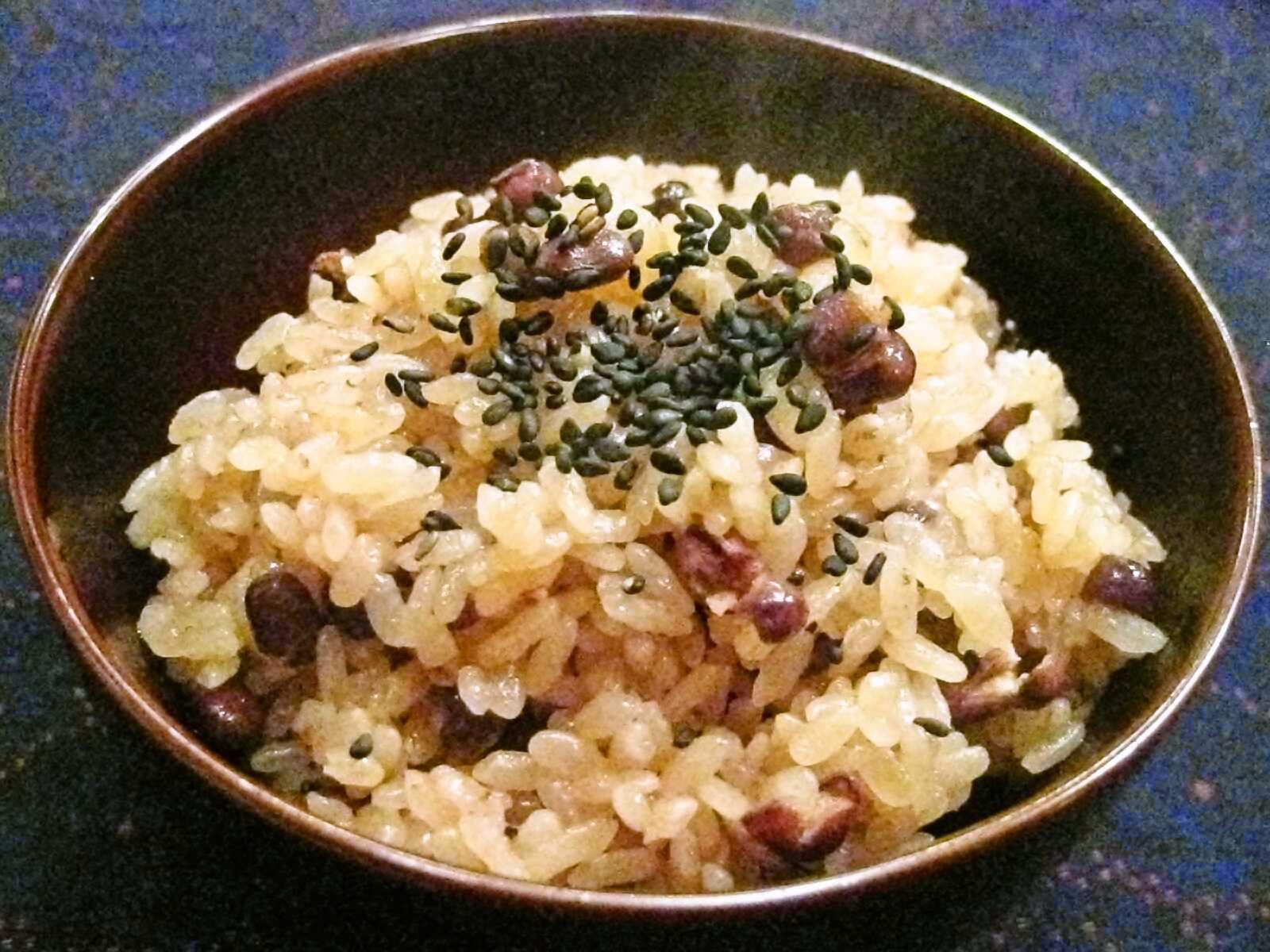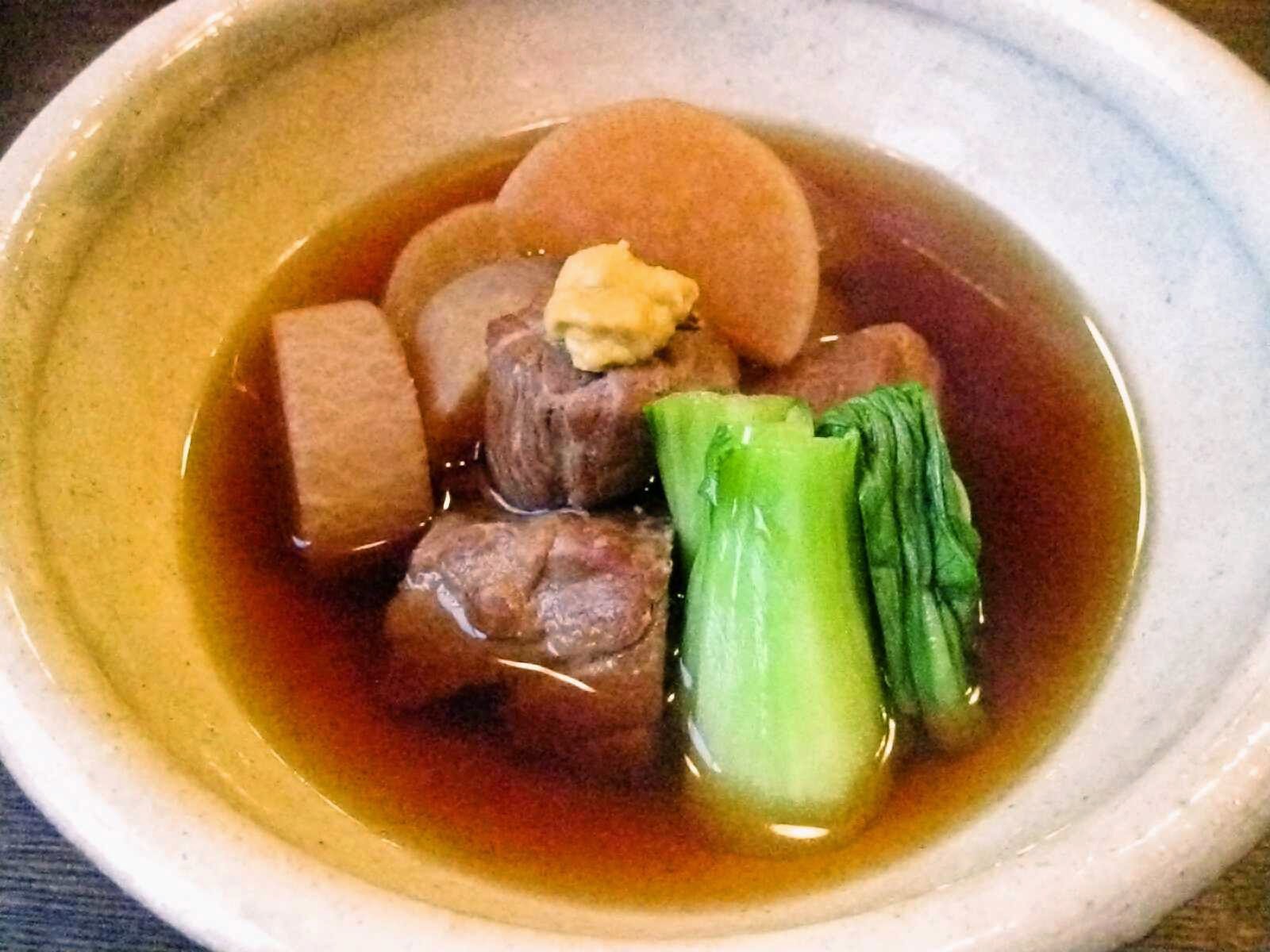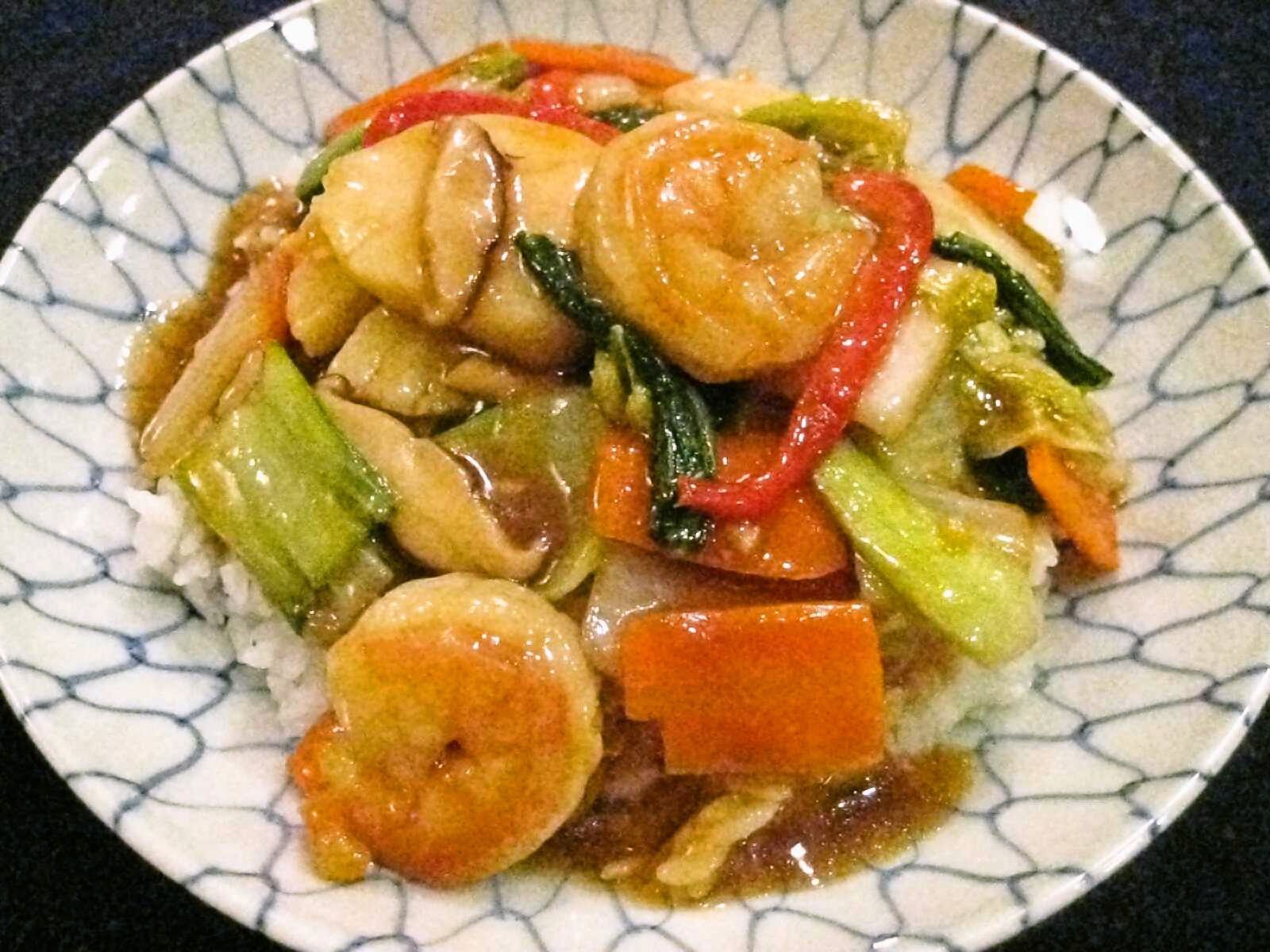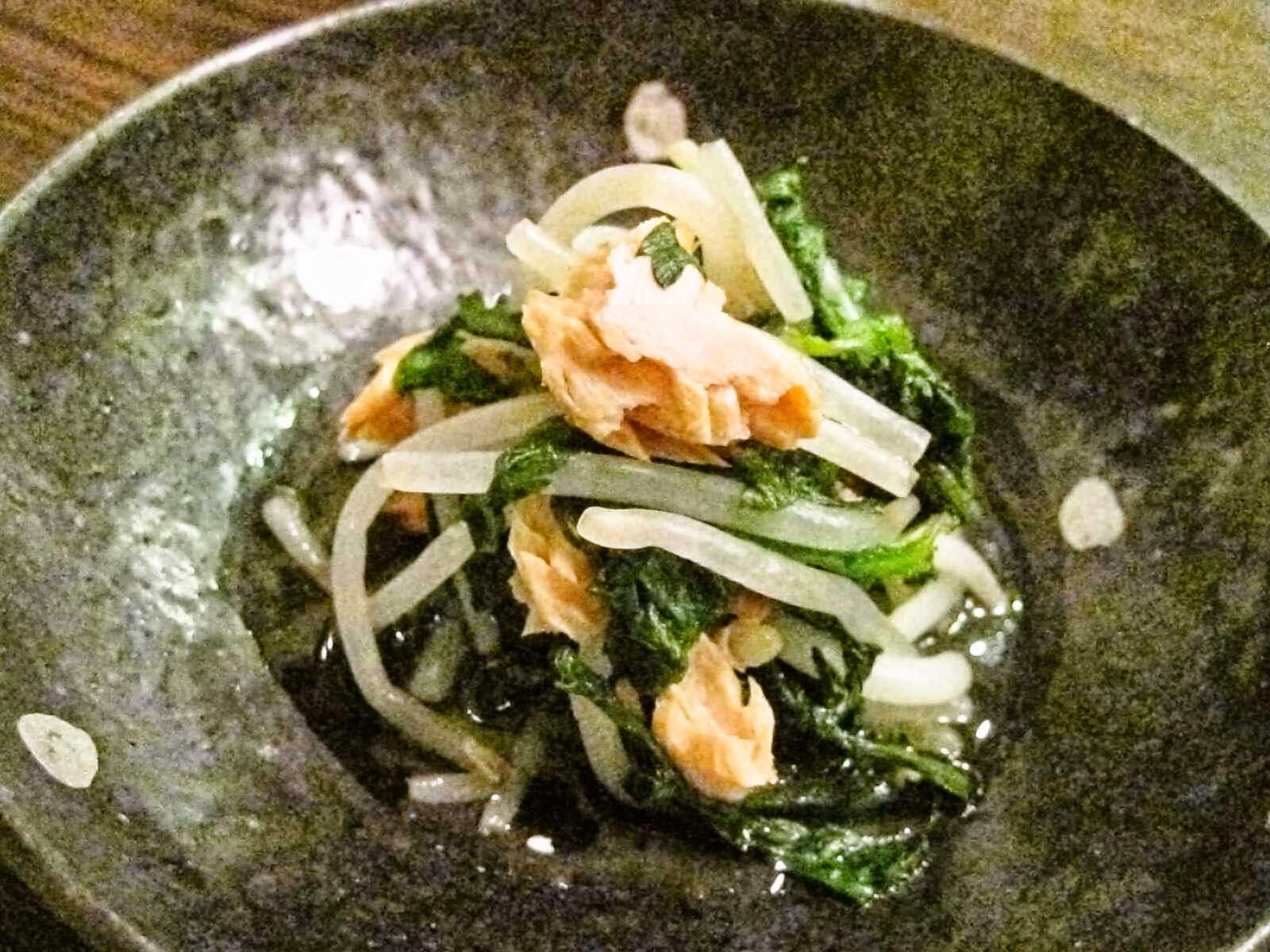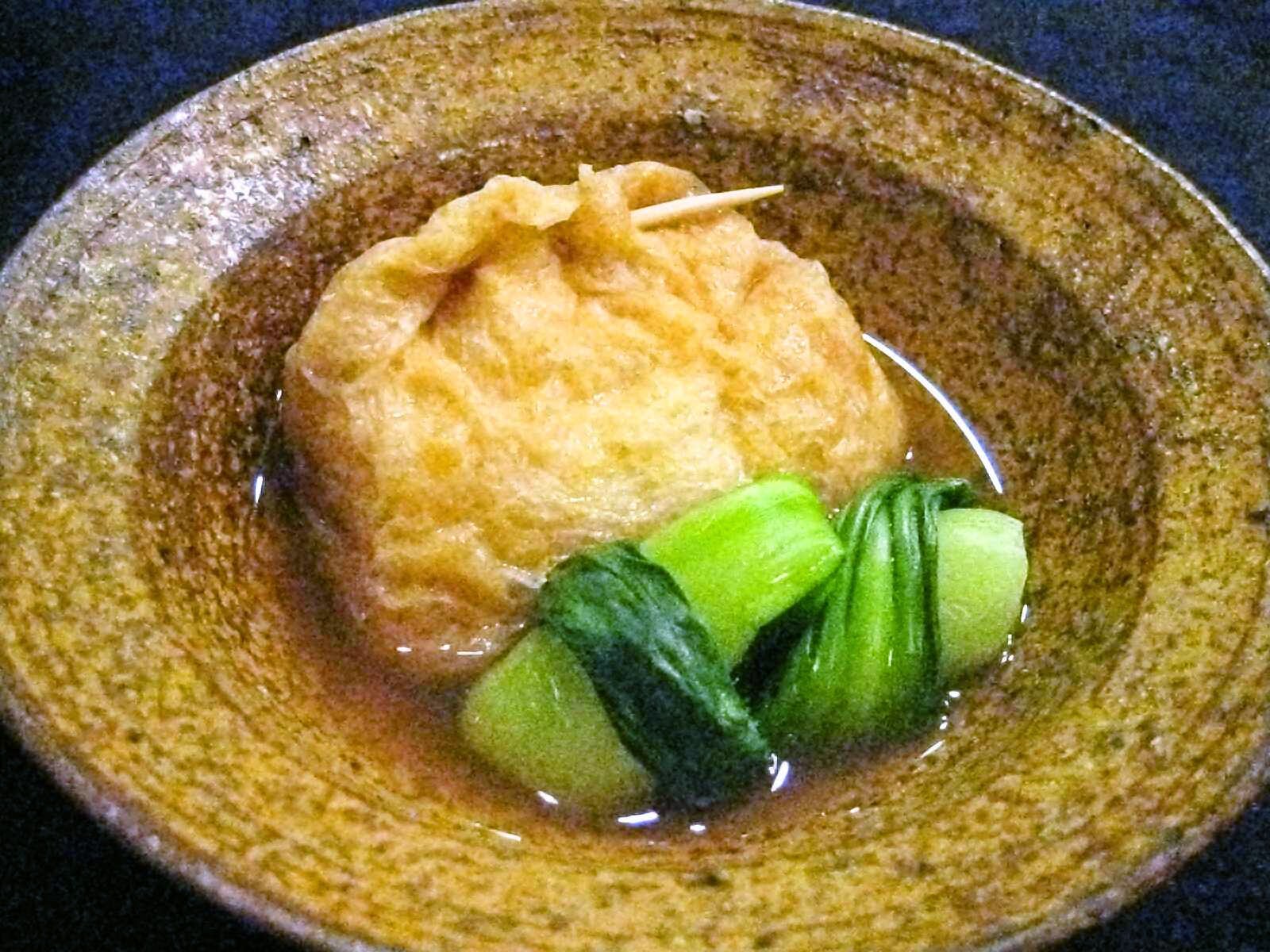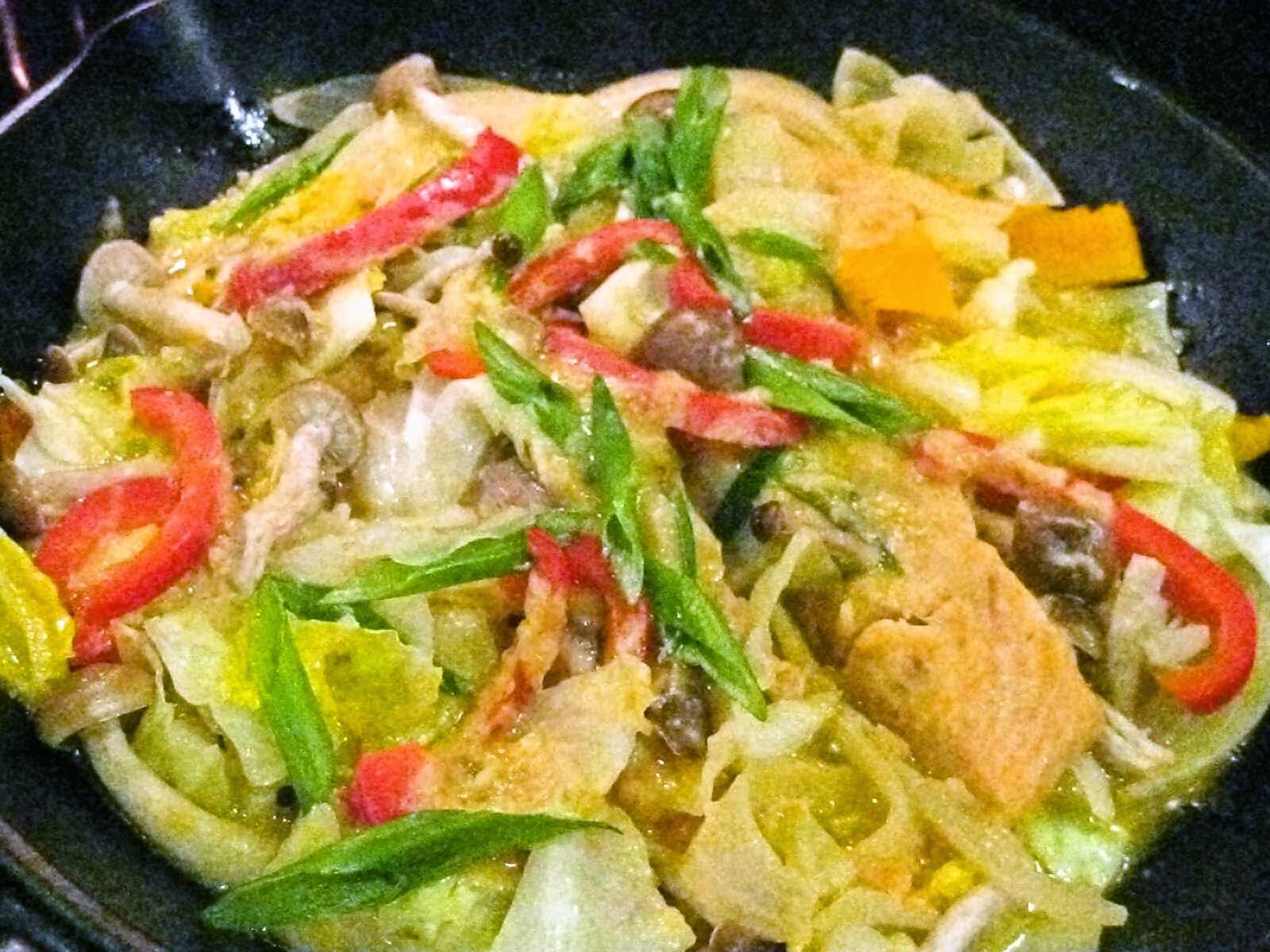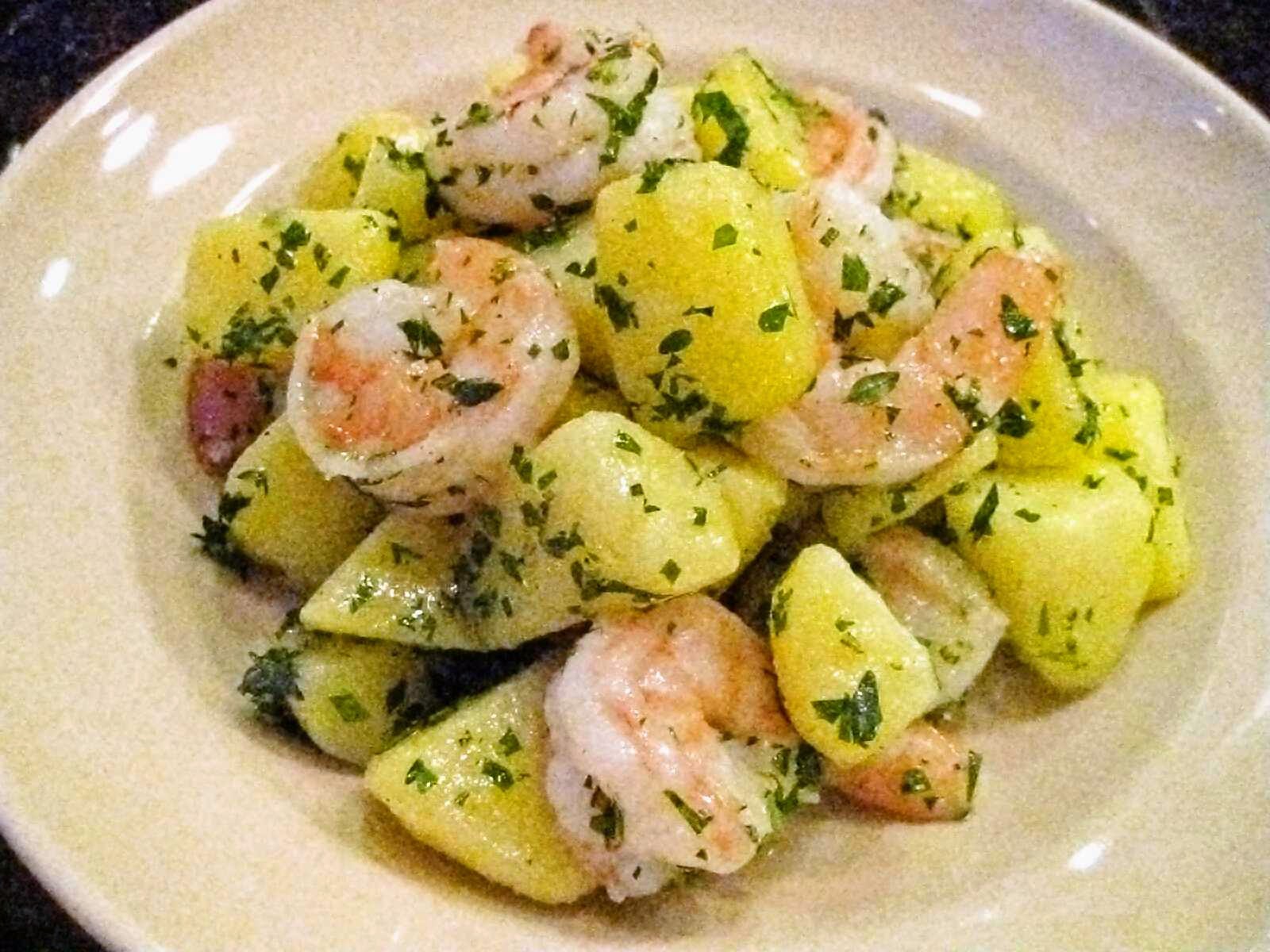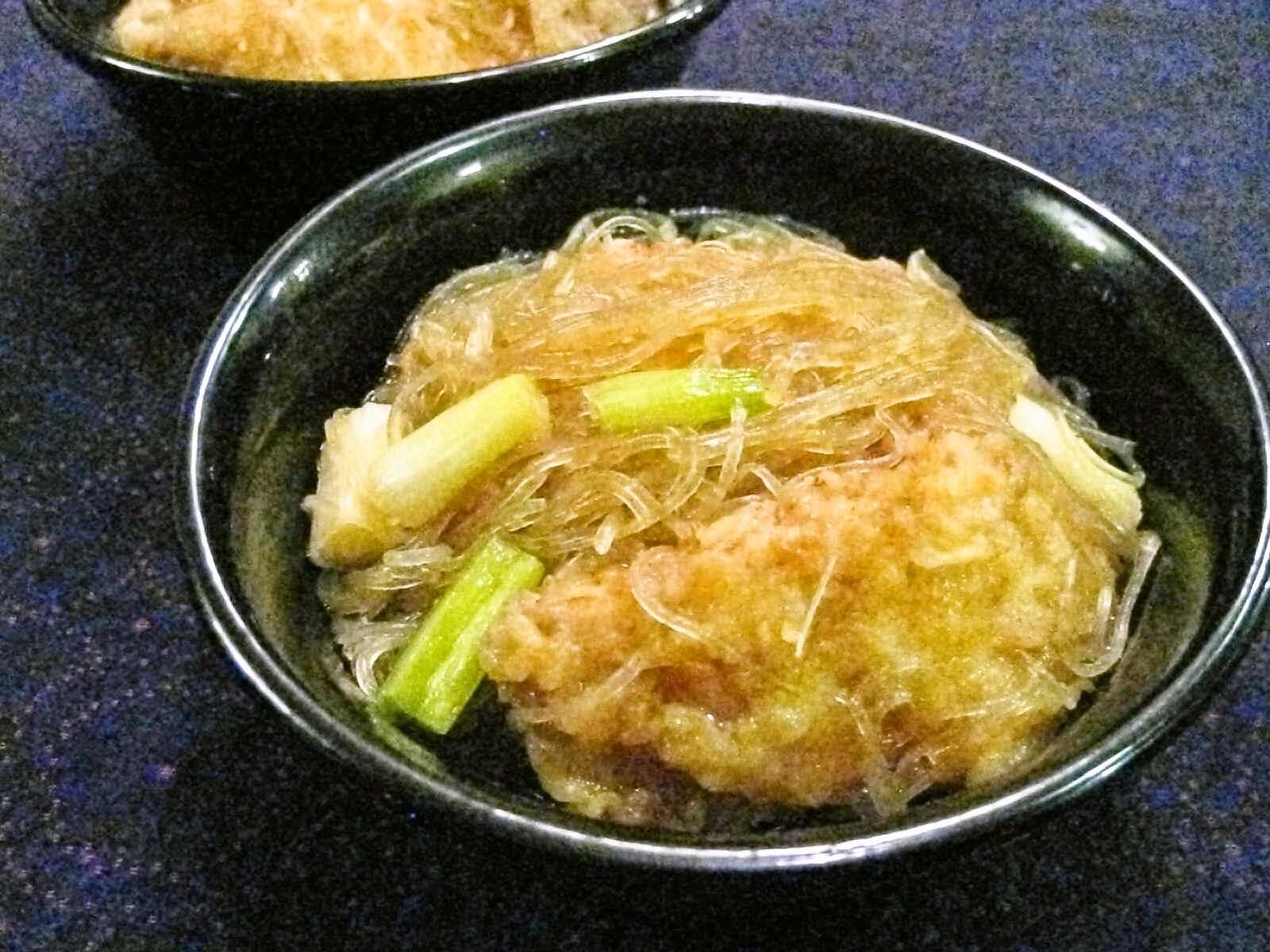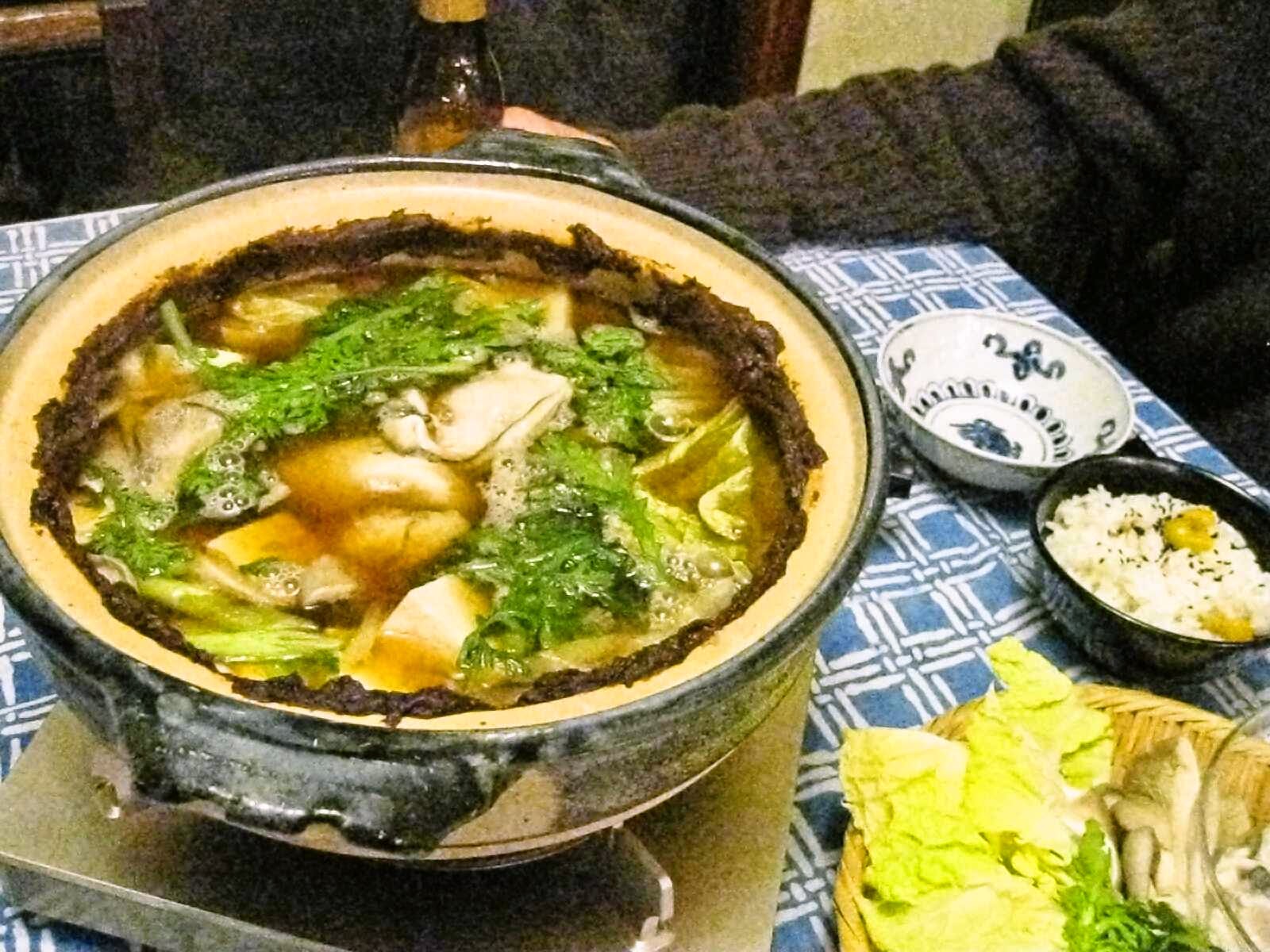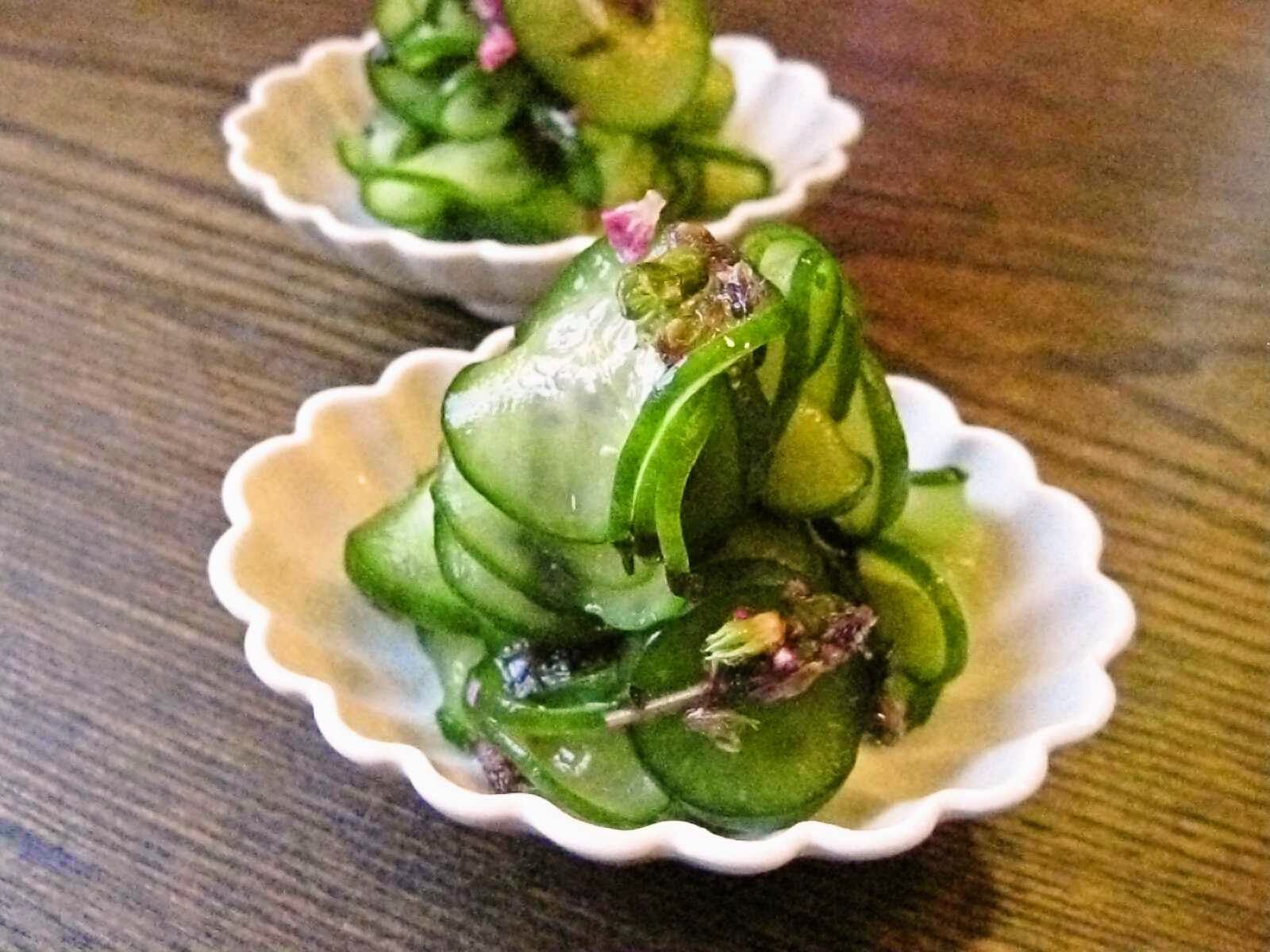All recipes are for 2 servings unless noted. Oil is canola oil and salt is kosher salt.
2012-12-31
2012-12-30
Gindara no yuanyaki / grilled yuan-marinated black cod
Black cod with a sweet and pleasant citrusy taste from yuan marinade (soy sauce, mirin and sake with yuzu citrus). A good alternative to grilled saikyozuke black cod marinated in sweet Saikyo miso.
2012-12-29
Surenkon / subasu / lotus root marinated in sweetened rice vinegar
Labels:
10 min,
2 easy,
bento,
boil,
make ahead,
marinate,
osechi,
picnic,
Recipes - Japanese,
renkon,
vegetables
Hanarenkon / flower-cut lotus root
2012-12-26
Horenso to kani no shogazu-ae / spinach and crab in ginger vinegar dressing
Labels:
1 very easy,
10 min,
blanch,
crab,
Recipes - Japanese,
spinach
2012-12-24
Umeninjin no nimono, shoga-aji / plum-blossom cut carrot simmered in light ginger-flavored broth
A part of takiawase -- assorted vegetables and tofu separately cooked in broth -- for New Year's osechi food. The slightly sweet ginger-flavored broth is one of my favorites for takiawase carrots.
Labels:
1 very easy,
30 min,
bento,
carrots,
make ahead,
osechi,
party,
picnic,
Recipes - Japanese,
simmer
2012-12-23
Buta no kakuni / stewed pork
Among the wide range of variations -- from somewhat firm to heavenly soft, as well as light to heavy -- this kakuni is at the soft, light and non-greasy end. While extra fatty pork belly is the cut of choice for a supremely soft texture, country-style rib, which is more commonly available in the US, is used here. Okara soybean pulp is the secret to removing extra fat and tenderizing pork at the same time in prep-cooking.
Labels:
120+ min (2+ hrs),
2 easy,
daikon,
make ahead,
okara,
pork,
Recipes - Japanese,
stew
2012-12-22
Tatsai to ninjin no okarani / ta cai, carrot and soybean pulp simmered in broth
A humble okara and vegetable dish enriched by sakura ebi dried shrimp and ta cai, a leafy Chinese green.
Labels:
10 min,
2 easy,
bento,
carrots,
microwave,
okara,
Recipes - Japanese,
sakura ebi,
saute,
simmer,
ta cai,
vegetables
2012-12-20
Yasai nukigata / vegetable cutters
Handy tools to cut vegetables into flowers or blossoms for different seasons.
From left: ume plum blossom (late winter/early spring); sakura cherry blossom (spring); kikyo Japanese bell flower (summer); kiku chrysanthemum (fall)
From left: ume plum blossom (late winter/early spring); sakura cherry blossom (spring); kikyo Japanese bell flower (summer); kiku chrysanthemum (fall)
2012-12-19
Nejiriume / plum-blossom cut carrots
For celebrations such as New Year’s, carrots often appear in the shape of a plum blossom. Plum blossoms symbolize early spring, and red blossoms in particular are prized for their celebratory color (red, often in combination with white, is for happy occasions). Some carrots have a reddish color, and those types are usually recommended. The orange of an average carrot still makes a pretty plum blossom. Carrots can be hand-cut or formed with a vegetable cutter.
Labels:
carrots,
Ingredient preparation,
kazarikiri,
osechi,
vegetables
2012-12-18
Kyabetsu to satsumaage no itameni / saute-simmered cabbage and deep-fried fishcakes
The “green” taste of cabbage’s outer leaves turns sweet from sauteing and is further softened by cooking with satsumaage in broth, resulting in a juicy, flavorful dish.
Labels:
2 easy,
30 min,
bento,
cabbage,
fishcake,
Recipes - Japanese,
satsumaage,
saute,
simmer,
vegetables
2012-12-17
Yakimochi to satojoyu / grilled rice cakes, with sweetened soy sauce dip
This is the standard way to eat mochi rice cakes, mainly as a snack, at my parents’ and relatives’ homes.
2012-12-15
Chukadon / Chinese-style saute with sauce over steamed rice
Another standard Japanese Chinese dish. Assorted ingredients are sauteed and flavored in Chinese style -- often meaning a combination of ginger, garlic, chicken stock, and oyster sauce. Here is one example with prawns and scallops.
When served with 150 g steamed rice:
428 calories per serving (1/2 of recipe); 17.1 g protein; 3.0 g fat; 79.0 g carbohydrate; 75.9 g net carbs; 1077 mg sodium (with 50% reduced-sodium soy sauce; 1419 mg with regular soy sauce); 53 mg cholesterol; 3.1 g fiber
When served with 150 g steamed rice:
428 calories per serving (1/2 of recipe); 17.1 g protein; 3.0 g fat; 79.0 g carbohydrate; 75.9 g net carbs; 1077 mg sodium (with 50% reduced-sodium soy sauce; 1419 mg with regular soy sauce); 53 mg cholesterol; 3.1 g fiber
Labels:
3 moderate,
30 min,
carrots,
chingensai,
hakusai,
prawns,
Recipes - Japanese,
red pepper,
rice,
saute,
scallops,
seafood,
shiitake,
shrimp,
stir-fry
2012-12-12
Shungiku, moyashi, shiozake no ohitashi / garland chrysanthemum, bean sprouts and grilled salted salmon marinated in light broth
A great combination! Tangy chrysanthemum, crispy bean sprouts and flavorful grilled salted salmon are infused with dashi, resulting in a delightful small dish.
Labels:
2 easy,
30 min,
blanch,
fish,
grill,
marinate,
moyashi,
Recipes - Japanese,
salmon,
seafood,
shiozake,
shungiku,
vegetables
2012-12-11
Daikon to usuage no nimono / daikon radish and thin deep-fried tofu simmered in broth
Labels:
2 easy,
60 min,
daikon,
make ahead,
Recipes - Japanese,
simmer,
usuage,
vegetables
2012-12-09
Kaki no remon marine / lemon-marinated persimmon
Labels:
1 very easy,
lemon,
make ahead,
no cook,
persimmon,
Recipes - Japanese,
Recipes - Western
2012-12-08
Nagaimo no ebi-iri kinchuakuni / Chinese yam with prawns in thin deep-fried tofu packets, simmered in broth
The soft texture and taste of nagaimo, enhanced with prawns and a fall harvest of gingko nuts and mushrooms.
Labels:
3 moderate,
30 min,
gingko nuts,
make ahead,
moderate,
nagaimo,
prawns,
Recipes - Japanese,
seafood,
shiitake,
shrimp,
simmer,
vegetables
2012-12-06
Tomyo to chikuwa no nibitashi / pea shoots and chikuwa fishcake simmered in light broth
A very quick, warm side dish. The stems of tomyo pea shoots stay crisp even when cooked and make this little dish stand tall. Their texture contrasts well with soft fishcake, which adds a mellow salty taste as you bite in.
Labels:
1 very easy,
10 min,
chikuwa,
fishcake,
Recipes - Japanese,
tomyo,
vegetables
2012-12-05
Ginnan gohan / gingko nut rice
Nutty, starchy little gingko nuts are another reminder of fall. Lightly salted to bring out the soft sweetness of mochigome rice.
Labels:
2 easy,
60 min,
bento,
boil,
gingko nuts,
picnic,
Recipes - Japanese,
rice,
steam
2012-12-04
Breakfast, December 3, 2012
We had lunch with Tom's sister and niece at Shanghai Garden in Seattle yesterday. My favorite dish at the restaurant is pea vine (shoot) saute. It is a very common dish, and Shanghai Garden’s pea vine saute tastes as good as those I used to have in Taiwan. Pea vine saute is not a fancy “wow” dish, but it certainly hit the spot and inspired me to make a decent breakfast the following day with ingredients we already have on hand and something just purchased in Seattle.
Ginnan gingko nut prep
Gingko nut shells can easily be cracked open with a tool, ranging from a hammer to a heavy knife handle or bottle opener. Something slightly heavy usually works better. Kitchen scissors and pliers could smash shells, and require some practice for effective use.
Opening shell
Hold a gingko nut with one of the side ridges straight up, and quickly hit the ridge with a hammer, heavy bottle opener or a tool of your choice.
Opening shell
Hold a gingko nut with one of the side ridges straight up, and quickly hit the ridge with a hammer, heavy bottle opener or a tool of your choice.
2012-12-03
Sake no chanchanyaki / salmon and vegetable saute with miso sauce
A regional dish from Hokkaido that includes salmon, cabbage, onions and other vegetables. Sweetened miso sauce sends off an appetizing aroma as you cook – take the frying pan to the table or cook on a tabletop griddle and enjoy the dish as it cooks.
Labels:
2 easy,
30 min,
cabbage,
carrots,
fish,
green onions,
hakusai,
kabocha,
onions,
Recipes - Japanese,
red pepper,
salmon,
saute,
seafood,
shimeji,
steam,
vegetables
2012-12-01
Ginnan gingko nuts
Seeds of Gingko biloba
2012-11-30
Jagaimo to ebi no remon haabu sarada / potato and prawn salad with herbs
This has been my top potluck and party dish for years. Lemon juice and fresh herbs turn this starchy salad into a light dish. No matter how many times I make it, I never get tired of eating it.
2012-11-28
Konnyaku no nimono / konnyaku yam cake simmered in broth
A somewhat straightforward, soy sauce-flavored dish that reminds me of dishes that appeared at my grandmother’s house.
29 calories (1/2 of recipe); 0.9 g protein; 0 g fat; 5.0 g carbohydrate; 3.3 g net carbs; 240 mg sodium (with 50% reduced-sodium soy sauce; 468 mg with regular soy sauce); 0 mg cholesterol; 1.7 g fiber
*See Notes for seasonings for a lower-sodium version.
29 calories (1/2 of recipe); 0.9 g protein; 0 g fat; 5.0 g carbohydrate; 3.3 g net carbs; 240 mg sodium (with 50% reduced-sodium soy sauce; 468 mg with regular soy sauce); 0 mg cholesterol; 1.7 g fiber
*See Notes for seasonings for a lower-sodium version.
Labels:
1 very easy,
10 min,
bento,
konnyaku,
picnic,
Recipes - Japanese,
simmer
2012-11-26
Hakusai to kani no chanpuruu (champuruu) / Okinawan-style saute with crab, tofu and napa cabbage
The sweet inner leaves of hakusai are a great match with crabmeat. Together with tofu and egg, this is a satisfying, flavorful and nutritious dish for an everyday meal. Bonito flakes added at the end give a rich flavor.
Labels:
1 very easy,
30 min,
bento,
crab,
eggs,
hakusai,
Recipes - Japanese,
saute,
seafood,
stir-fry,
tofu,
vegetables
2012-11-24
Eringi to burokkorii no sotee sarada / sauteed king oyster mushrooms and broccoli salad
Tender, somewhat chewy eringi contrasts well with crunchy broccoli. Due to the very light saute, this is like a hot salad.
Labels:
10 min,
2 easy,
broccoli,
eringi,
Recipes - Japanese,
saute,
vegetables
2012-11-23
2012-11-22
Breakfast, November 21, 2012
It is the day before the buttery-sugary feast. Recent radio shows about how to prepare turkey and side dishes make me feel full already. One of the most recent programs emphasized the importance of butter.
We do not use butter excessively even with Western food, but tomorrow’s food is an annual exception. I will have six dishes with butter: panna cotta of beets, gougère, crispy cauliflower salad, baked yams, salmon-potato spread, and pumpkin cheesecake. Some only use less than 1 tsp of butter, but all together they are buttery. To counter the highly likely overdose, we had a butter-less breakfast as usual.
2012-11-21
Oden / fishcake, tofu and daikon radish stew
With its steam and heavenly aroma wafting up from a large, softly bubbling pot, this dish envelops you in a comforting warmth, and is a mainstay of cold winter months. It is available at specialty restaurants, street stalls and even convenience stores -- and, of course, at home. This is my standard oden as passed down by my mom, with the addition of some techniques adopted from her friend's oden restaurant.
Labels:
120+ min (2+ hrs),
3 moderate,
carrots,
chikuwa,
daikon,
eggs,
fishcake,
gingko nuts,
hanpen,
konnyaku,
make ahead,
mochi,
potatoes,
Recipes - Japanese,
satsumaage,
usuage,
yakidofu
2012-11-20
Daikon to kaki no namasu / daikon radish and persimmon in sweetened rice vinegar
A fruity affair with sweet persimmon. The sweetness of persimmon, the saltiness from daikon radish and the mild sourness of rice vinegar and lemon juice blend together after some time, resulting in a pleasant little side dish.
Labels:
1 very easy,
30 min,
bento,
daikon,
make ahead,
marinate,
no cook,
osechi,
persimmon,
picnic,
Recipes - Japanese,
vegetables
2012-11-18
Tori no karaage / fried chicken
The standard dish for picnics, parties and bento lunch boxes – probably one of the top 10 bento items I made in my high school days. I’m still using the same recipe.
2012-11-17
Gobo to toriniku no amakarani / salty-sweet simmered burdock root and chicken
Labels:
1 very easy,
30 min,
bento,
chicken,
gobo,
make ahead,
picnic,
Recipes - Japanese,
simmer
2012-11-15
Konnyaku to tamanegi no itameni / saute-simmered konnyaku yam cake and onion
Among a number of quick konnyaku dishes, this tastes slightly similar to sukiyaki. A nice companion with a rich punch for mild-flavored dishes.
Labels:
1 very easy,
30 min,
bento,
konnyaku,
make ahead,
onions,
picnic,
Recipes - Japanese,
saute,
simmer
2012-11-09
Atsuage to mizuna no mishoshiru / miso soup with deep-fried tofu and mizuna
Labels:
1 very easy,
10 min,
atsuage,
mizuna,
Recipes - Japanese,
simmer,
soup,
vegetables
2012-11-07
Kaki no dote-nabe / hot pot with oysters, broiled tofu and vegetables with miso
Miso is pasted along the inside edge of the pot so you can adjust the taste as you eat. The combination of oysters, miso and a squeeze of lemon is warm yet refreshing. Vegetables, broiled tofu and other ingredients contribute to the mild broth, making this hot pot very satisfying.
Labels:
2 easy,
30 min,
daikon,
green onions,
hakusai,
hiratake,
konnyaku,
oysters,
party,
Recipes - Japanese,
seafood,
shungiku,
simmer,
vegetables,
yakidofu
2012-11-05
Chikuwa to kinoko no nibitashi / chikuwa fishcakes and mushrooms in broth
Labels:
1 very easy,
30 min,
bento,
chanterelle,
chikuwa,
enoki,
fishcake,
make ahead,
Recipes - Japanese,
shiitake,
shimeji,
simmer
2012-11-03
Kaki to shungiku no kurumizu-ae / persimmon and garland chrysanthemum in sweetened vinegar with walnuts
“Wow!” Tom said, after his first bite. Sweet orange-colored autumn fruit is paired with aromatic garland chrysanthemum, with lightly sweetened vinegar and walnuts smoothly working as a go-between.
Labels:
2 easy,
30 min,
bento,
blanch,
persimmon,
Recipes - Japanese,
shungiku,
vegetables,
walnuts
2012-11-02
Ebi to ginnan-iri mushi-renkon manju / steamed lotus root dumplings with prawns and gingko nuts
Grated lotus root is transformed into soft dumplings by steaming. Prawns add a mild sweet flavor while gingko nuts provide the nutty tang of autumn.
Labels:
3 moderate,
30 min,
gingko nuts,
mizuna,
prawns,
Recipes - Japanese,
renkon,
seafood,
steam,
vegetables
2012-10-29
2012-10-26
Warabi, konnyaku, satsumaage no itameni / saute-simmered bracken, konnyaku yam cake and deep-fried fishcake in broth
Somewhat crunchy warabi bracken makes a good contrast to tender fishcake and soft yet chewy konnyaku yam cake. A tasty, low-key companion for plain steamed rice and sake.
Labels:
2 easy,
30 min,
bento,
fishcake,
konnyaku,
make ahead,
Recipes - Japanese,
satsumaage,
saute,
simmer,
warabi
2012-10-24
Kasetto konro / table-top portable gas stove
The compact table-top portable gas stove is incredibly handy for the nabe hot-pot season. Nabe is all about enjoying food cooking right in front of you with family and friends, and a portable gas stove makes it so easy to have a good time at your table.
These stoves take butane cartridges. Cartridges used to be available only at Asian supermarkets but are now available even at our local outdoor shops.
These stoves take butane cartridges. Cartridges used to be available only at Asian supermarkets but are now available even at our local outdoor shops.
2012-10-23
Arugula to kabocha no gomasoosu-gake / arugula and kabocha pumpkin with sesame sauce
When you want something lighter than gomaae, this is a good option. The sesame-like nutty taste of arugula is a natural with sesame sauce. You just need to counter it with naturally sweet, in-season kabocha pumpkin. Lots of fresh green arugula also helps to lighten up the pumpkin, which could taste a bit heavy because of its starchiness.
Labels:
1 very easy,
10 min,
arugula,
kabocha,
microwave,
Recipes - Japanese,
vegetables
2012-10-20
Kobashira, shiitake, mitsuba no kakiage / mixed tempura with bay scallops, shiitake mushrooms and mitsuba
The classic combination of kobashira bay scallops and mitsuba is stunning in tempura. Shiitake mushrooms add an earthy note and tender texture.
Labels:
3 moderate,
30 min,
baby scallops,
deep-fry,
mitsuba,
Recipes - Japanese,
seafood,
shiitake,
vegetables
2012-10-18
Atsuage no guriru, yasai ankake / grilled deep-fried tofu with thickened vegetable sauce
An, sauce thickened with potato starch, quickly transforms atsuage into a more satisfying dish with a mild flavor.
Labels:
2 easy,
30 min,
atsuage,
carrots,
green onions,
grill,
Recipes - Japanese,
shimeji,
shishito,
simmer,
vegetables
2012-10-16
Kyuri to hanaho no sunomono / Japanese cucumber and perilla flowers in sweetened rice vinegar
The softly refreshing taste and aroma of pink shiso flowers add a pleasant touch to this standard kyuri dish.
Labels:
1 very easy,
30 min,
hanaho,
kyuri,
no cook,
Recipes - Japanese,
shiso,
vegetables
2012-10-15
Robusutaa masshuruumu no guriru / grilled lobster mushrooms
Labels:
1 very easy,
10 min,
grill,
mushrooms,
Recipes - Japanese
2012-10-14
Breakfast, October 12, 2012
Tom has been a star in our kitchen lately. He bakes great bread. He is getting really good at pozole and dishes with beans, from soup to salad. He repeatedly made jabara kyuri to use as many cucumbers as possible from the greenhouse. He cooked warabi bracken for the first time, grilled eggplant for the first time, used a tortilla press for the first time, and he tried my new daikon radish grater for the first time – all in the last few weeks.
I get cranky, however, because of an insufficient variety and amount of vegetables. On a deadline-free, stress-free day after a few weeks of a hectic work schedule, one word was echoing in my head – vegetables, vegetables, vegetables….
I get cranky, however, because of an insufficient variety and amount of vegetables. On a deadline-free, stress-free day after a few weeks of a hectic work schedule, one word was echoing in my head – vegetables, vegetables, vegetables….
2012-10-13
Gindara no kareejoyu-ni / black cod simmered in curry soy sauce broth
A mellow and mild black cod dish accentuated by aromatic curry and soy sauce broth. Semi-steamed cauliflower adds a gentle, sweet note.
Labels:
2 easy,
30 min,
cauliflower,
fish,
Recipes - Japanese,
seafood,
simmer,
steam,
vegetables
Subscribe to:
Posts (Atom)
